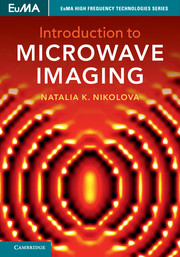Book contents
- Frontmatter
- Dedication
- Epigraph
- Contents
- Preface
- Notation
- Acronyms
- 1 Scalar-Wave Models in Electromagnetic Scattering
- 2 Electromagnetic Scattering: The Vector Model
- 3 Scattering Parameters in Microwave Imaging
- 4 Linear Inversion in Real Space
- 5 Linear Inversion in Fourier Space
- 6 Performance Metrics in Imaging
- 7 Looking Forward: Nonlinear Reconstruction
- Appendix A Maxwell's Equations
- Appendix B Electromagnetic Vector Wave and Helmholtz Equations
- Appendix C Scalarized Electromagnetic Models
- Appendix D Causal, Acausal, and Adjoint Solutions to the Wave Equation
- References
- Index
5 - Linear Inversion in Fourier Space
Published online by Cambridge University Press: 08 July 2017
- Frontmatter
- Dedication
- Epigraph
- Contents
- Preface
- Notation
- Acronyms
- 1 Scalar-Wave Models in Electromagnetic Scattering
- 2 Electromagnetic Scattering: The Vector Model
- 3 Scattering Parameters in Microwave Imaging
- 4 Linear Inversion in Real Space
- 5 Linear Inversion in Fourier Space
- 6 Performance Metrics in Imaging
- 7 Looking Forward: Nonlinear Reconstruction
- Appendix A Maxwell's Equations
- Appendix B Electromagnetic Vector Wave and Helmholtz Equations
- Appendix C Scalarized Electromagnetic Models
- Appendix D Causal, Acausal, and Adjoint Solutions to the Wave Equation
- References
- Index
Summary
In this chapter, methods for image reconstruction, both qualitative and quantitative, are described that solve a linearized model of scattering in Fourier space. They are referred to as spectral-domain reconstruction methods. In all of these methods, the data sets, which are originally functions of the observation position in real space (e.g., x and y), are subjected to Fourier transformation. The reconstruction of the object's contrast function is then performed in Fourier space, e.g., with respect to kx and ky (the Fourier variables corresponding to x and y). This necessitates a final step of an inverse Fourier transform to return the result in real space. This category of reconstruction methods includes MW holography, diffraction tomography, and a great variety of techniques used to produce imagery from synthetic aperture radar (SAR) measurements.
The spectral-domain reconstruction methods are well studied. Their greatest advantage is that they are fast, allowing for image generation in real time. Their disadvantage is that, like other linear inversion methods, they are limited to problems where multiplescattering and mutual-coupling effects in the object under test (OUT) can be neglected. They are the workhorse of the real-time MW and millimeter-wave imaging systems with various applications in concealed weapon detection [62, 63, 164, 165, 166], nondestructive testing [167–173], medical-imaging research [174–179], antenna measurements [180, 181], and many other areas.
The subject of reconstruction in Fourier space is extensive, and it would be impossible to present it in its entirety here. The goal here is to introduce its basic principles and to give the reader an appreciation for the mathematical beauty of the methodology and its power in real-life applications. MW holography is chosen as the method through which the reader is introduced to the subject. There are several reasons for this choice. First, modern MW holography is akin to SAR reconstruction; in fact, it was developed as an extension of SAR to 3D imaging with data acquired on planes. Thus, it can serve as a sound basis for further studies of the various SAR imaging methods. Second, when applied in a cylindrical coordinate system, MW holography can also be viewed as an extension of diffraction tomography to 3D imaging. Third, MW holography is arguably the most widely used real-time reconstruction method applied to data in the MW and millimeter-wave frequency ranges.
- Type
- Chapter
- Information
- Introduction to Microwave Imaging , pp. 236 - 265Publisher: Cambridge University PressPrint publication year: 2017



